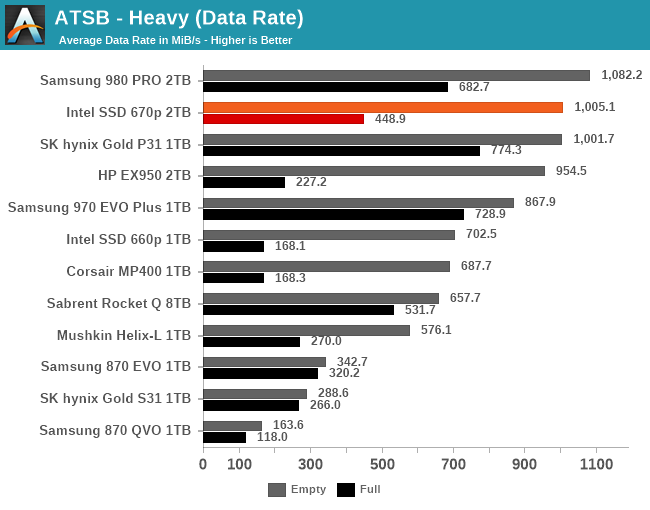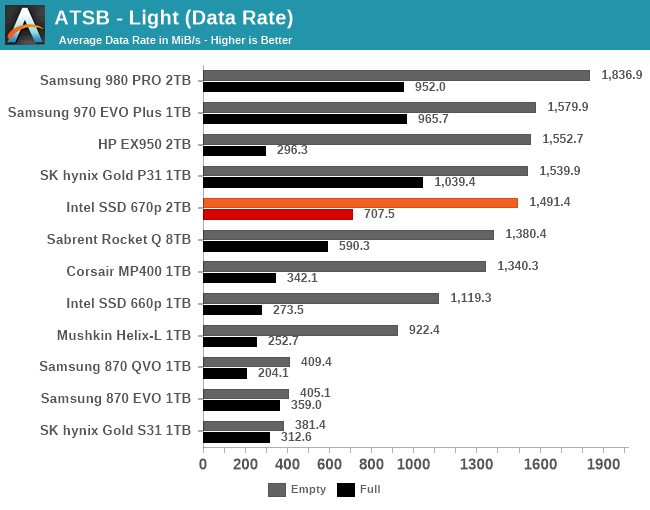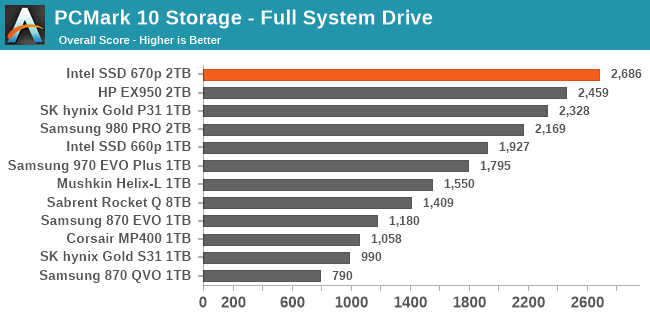The Intel SSD 670p (2TB) Review: Improving QLC, But Crazy Pricing?!?
by Billy Tallis on March 1, 2021 12:00 PM ESTAnandTech Storage Bench - The Destroyer
Our AnandTech Storage Bench tests are traces (recordings) of real-world IO patterns that are replayed onto the drives under test. The Destroyer is the longest and most difficult phase of our consumer SSD test suite. For more details, please see the overview of our 2021 Consumer SSD Benchmark Suite.
 |
|||||||||
| Average Data Rate | |||||||||
| Average Latency | Average Read Latency | Average Write Latency | |||||||
| 99th Percentile Latency | 99th Percentile Read Latency | 99th Percentile Write Latency | |||||||
| Energy Usage | |||||||||
The SLC cache on the 2TB Intel 670p isn't large enough for The Destroyer to operate entirely within the cache, as we saw with the massive 8TB Sabrent Rocket Q. But the big SLC cache is still enough for the 670p to score very well overall on this test, clearly outperforming all the smaller entry-level NVMe SSDs we have tested, and more than a few mainstream and high-end models as well. The 670p's biggest weakness is with 99th percentile write latency, but even that score isn't problematic.
AnandTech Storage Bench - Heavy
The ATSB Heavy test is much shorter overall than The Destroyer, but is still fairly write-intensive. We run this test twice: first on a mostly-empty drive, and again on a completely full drive to show the worst-case performance.
 |
|||||||||
| Average Data Rate | |||||||||
| Average Latency | Average Read Latency | Average Write Latency | |||||||
| 99th Percentile Latency | 99th Percentile Read Latency | 99th Percentile Write Latency | |||||||
| Energy Usage | |||||||||
As with The Destroyer, the empty-drive test run of the Heavy test shows that the 670p's performance can compete with good TLC drives. It's only on the full-drive test run that the QLC NAND starts to hold back the 670p. Even so, it fares better than almost all the competing entry-level drives and keeps the 99th percentile latencies down to reasonable values.
AnandTech Storage Bench - Light
The ATSB Light test represents ordinary everyday usage that doesn't put much strain on a SSD. Low queue depths, short bursts of IO and a short overall test duration mean this should be easy for any SSD. But running it a second time on a full drive shows how even storage-light workloads can be affected by SSD performance degradation.
 |
|||||||||
| Average Data Rate | |||||||||
| Average Latency | Average Read Latency | Average Write Latency | |||||||
| 99th Percentile Latency | 99th Percentile Read Latency | 99th Percentile Write Latency | |||||||
| Energy Usage | |||||||||
On the Light test, the Intel 670p comes very close to matching the performance of mainstream TLC NVMe drives for both the empty and full drive test runs. Write latencies (average and 99th percentile) are still clearly higher than TLC drives, but not high enough to be a noticeable performance problem in storage-light real world usage. Power consumption is a bit on the high side, but that appears to be more due to the SSD controller than the downsides of QLC NAND.
PCMark 10 Storage Benchmarks
The PCMark 10 Storage benchmarks are IO trace based tests similar to our own ATSB tests. For more details, please see the overview of our 2021 Consumer SSD Benchmark Suite.
 |
|||||||||
| Full System Drive | Overall Score | Average Bandwidth | Average Latency | ||||||
| Quick System Drive | Overall Score | Average Bandwidth | Average Latency | ||||||
| Data Drive | Overall Score | Average Bandwidth | Average Latency | ||||||
Since we run the PCMark 10 Storage tests starting from an empty drive, the Intel SSD 670p is able to make full use of its large and very fast SLC cache. That puts it at the top of the charts for both the Quick System Drive and Full System Drive tests, and competitive with good TLC drives on the Data Drive test that is more geared toward sequential IO.










72 Comments
View All Comments
abufrejoval - Monday, March 1, 2021 - link
This is the kind of article, that keeps AT at the top of my daily reading list.While it's technically very neutral and to the point the last paragraph almost sound a bit like good old Charly Demerjan from Semiaccurate, who barely seems to peekt out behind his self-inflicted pay wall any more.
Nice job and I know why my last Intel SSD was a Postville, still running btw.
Hifihedgehog - Monday, March 1, 2021 - link
The interwebs gifted us the nickname of Faillake to describe Skylake, but have they come up yet with a clever name to adequately describe this pricing disaster? QLC-quandry? QLC-quagmire? I honestly don't know who would buy these except for the engineering team and the most ardent fanboys. By the way, the fanboys are very ticked off today by Billy Talis' extremely honest assessment and are downvoting other people as well who are calling the pricing "horrendous."Great_Scott - Tuesday, March 2, 2021 - link
Looks like AT is alone in talking about the pricing. I typically like HH, but they are way off base on that aspect of their review. That was a bummer to discover.A5 - Monday, March 1, 2021 - link
The conclusion here is bang-on. This is a pretty good QLC drive at a terrible price. It needs to be 10 or 11 cents/GB to be a winner.Glock24 - Monday, March 1, 2021 - link
That's more expensive than some good TLC drives 🤷🏻♂️powerarmour - Monday, March 1, 2021 - link
I refuse out of principle to ever purchase a QLC drive.Small Bison - Monday, March 1, 2021 - link
And for this particular drive, it doesn't take much principle to buy a better-performing TLC SSD for less money.Reflex - Monday, March 1, 2021 - link
I remember when everyone said this about TLC, yet here we are...JimmyZeng - Tuesday, March 2, 2021 - link
But for TLC this phase is much shorter, QLC is around for quite a few years, yet it failed to catch on, yeah 670 is crazily priced, but even with 660/665, they never showed any pricing advantage comparing to TLC competitors, I suppose the (rough) theoretical upper limit of 33%(4bpc/3bpc) capacity/price ratio improvement of QLC over TLC is at play here.utferris - Tuesday, March 2, 2021 - link
Learn some math before posting something.QLC (4 bit) is double the size of TLC (3 bit), not 4/3.
So theoretically, the same QLC flash can double the capacity than it is used as TLC. Although in reality, the cost of QLC can not go down to half of TLC, but it should be able to get close in the long run.